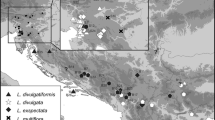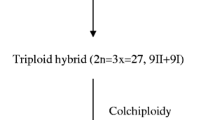Abstract
Oenothera nutans, common to the Appalachian Mts between 650 and 1 700 m altitude, was investigated cytogenetically and taxonomically. The species is permanently structurally heterozygous. It consists of two genomes of the B-type which are more or less indistinguishable phenotypically. Nearly all of the strains investigated possess a self-incompatibility factor in one of the two complexes. Both complexes show a close relationship to the predominantly homozygousO. grandiflora, a native of the southern lowlands.O. nutans andO. grandiflora possess the same plastid type, plastome III. Probably,O. nutans evolved by an accumulation of reciprocal translocations within an originally structurally homozygous population, which must be regarded ancestral to the present forms ofO. grandiflora.
Similar content being viewed by others
References
Alexander, M. P., 1969: Differential staining of aborted and nonaborted pollen. — Stain Technol.44: 117–122.
Bollinger, G., Herrmann, A., Moentmann, V. 1983: BMDP Statistikprogramme für die Bio-, Human- und Sozialwissenschaften. — Stuttgart: G. Fischer.
Cleland, R. E., 1958: The evolution of the North American oenotheras of the “biennis” group. — Planta51: 378–398
—, 1972:Oenothera cytogenetics and evolution. — London: Academic Press.
Correns, C., 1917: Ein Fall experimenteller Verschiebung der Geschlechtsverhältnisse. — Sitzungsber. Preuss. Akad. Wiss.1917: 685–717.
—, 1921: Zweite Fortsetzung der Versuche zur experimentellen Verschiebung der Geschlechtsverhältnisse. — Sitzungsber. Preuss. Akad. Wiss.1921: 330–354.
Dixon, W. J., 1981: BMDP-statistical software. — Berkley: University of California Press.
Muller, H. J., 1917: AnOenothera-like case inDrosophila. — Proc. Natl. Acad. Sci. Wash.3: 619–626.
Noher de Halac, I., Harte, C., 1977: Different pattern of callose wall formation during megasporogenesis in two species ofOenothera (Onagraceae). — Pl. Syst. Evol.127: 23–38.
Raven, P. H., 1979: A survey of reproductive biology inOnagraceae. — New Zealand J. Bot.17: 575–593.
—,Dietrich, W., Stubbe, W., 1979: An outline of the systematics ofOenothera subsect.Euoenothera (Onagraceae). — Syst. Bot.4: 242–252.
Renner, O., 1917: Die tauben Samen der Oenotheren. — Ber. Deutsch. Bot. Ges.34: 858–869.
—, 1919a: Über Sichtbarwerden der Mendelschen Spaltung in Pollen vonOenothera-bastarden. — Ber. Deutsch. Bot. Ges.37: 129–135.
—, 1919b: Zur Biologie und Morphologie der männlichen Haplonten einiger Oenotheren. — Z. Bot.11: 305–380.
Renner, O., 1940: Kurze Mitteilung überOenothera. 4. Über Beziehungen zwischen Heterogamie und Embryosackentwicklung und über diplarrhene Verbindungen. — Flora134: 145–158.
—, 1946: Artbildung in der GattungOenothera. — Naturwiss.33: 211–218.
Rodkiewicz, B., Bednara, H., Pora, H., 1971: Alternative localisation of the active megaspore in tetrads inOenothera muricata. — Bull. Acad. Pol. Sci. Ser. Sci. Biol., Cl. 2.,19: 691–694.
Sniezko, R., Harte, C., 1984: Polarity and competition between megaspores in the ovule ofOenothera hybrids. — Pl. Syst. Evol.144: 83–97.
Steiner, E., 1956: New aspects of the balanced lethal system inOenothera. — Genetics41: 486–500.
—,Stubbe, W., 1984: A contribution to the population biology ofOenothera grandiflora L'Her. — Amer. J. Bot.71: 1293–1301.
—, —, 1986:Oenothera grandiflora revisited: a new view of its population structure. — Bull. Torrey Bot. Club113: 406–412.
Stubbe, W., 1953: Genetische und zytologische Untersuchungen an verschiedenen Sippen vonOenothera suaveolens. — Z. induktive Abst. Vererb.85: 180–209.
—, 1959: Genetische Analyse des Zusammenwirkens von Genom und Plastom beiOenothera. — Z. induktive Abst. Vererb.90: 288–298.
—, 1980: Über die Bedingungen der Komplexheterozygotie und über die Evolution komplexheterozygotischer Arten beiOenothera. — Ber. Deutsch. Bot. Ges.93: 441–447.
—,Raven, P. H., 1979: Genetic self-incompatibility inOenothera subsect.Euoenothera. — Science204: 327.
Wasmund, O., 1980: Cytogenetische Untersuchungen zur Systematik einiger Sippen der SubsektionEuoenothera der GattungOenothera (Onagraceae). — Staatsexamen Univ. Düsseldorf.
—,Stubbe, W., 1986: Cytogenetic investigations onOenothera wolfii (Onagraceae). — Pl. Syst. Evol.154: 79–88.
Wishart, D., 1978: Clustan user manual. Program library unit. — Edinburgh: Edinburgh University Press.
Author information
Authors and Affiliations
Rights and permissions
About this article
Cite this article
Wasmund, O. Cytogenetic investigations onOenothera nutans (Onagraceae). Pl Syst Evol 169, 69–80 (1990). https://doi.org/10.1007/BF00935986
Received:
Issue Date:
DOI: https://doi.org/10.1007/BF00935986




